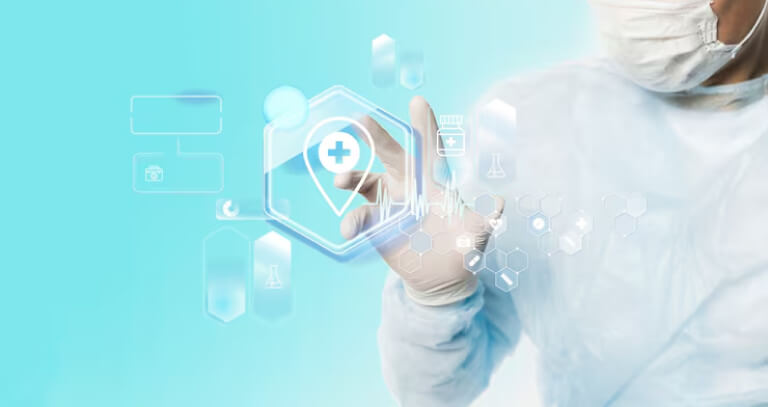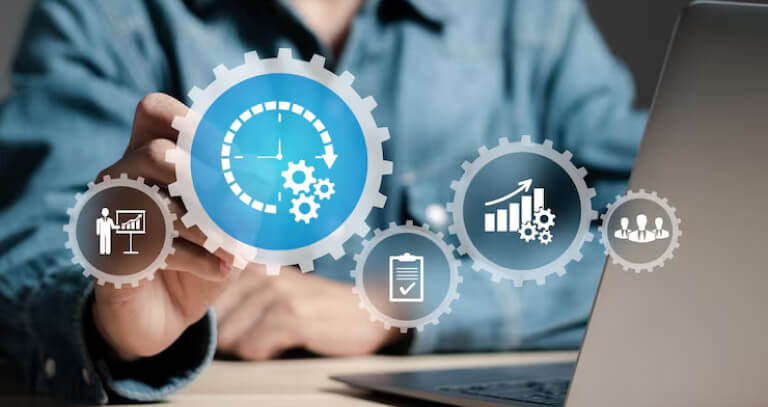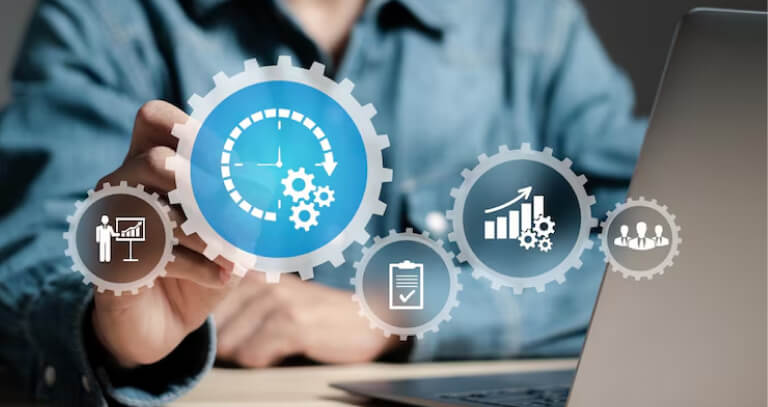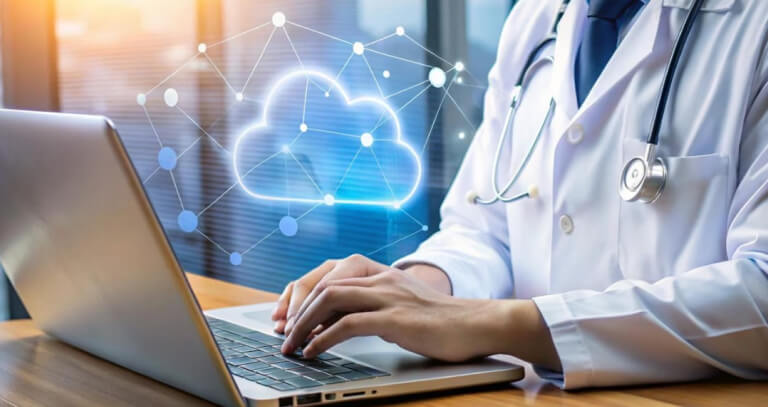5 Different Types Of Software Used In Healthcare Industry
Ditstek Blogs
The healthcare industry is undergoing a seismic shift driven by the power of technology. From improving patient care to transforming business operations, healthcare software is at the forefront of this transformation.
Gone are the days of paper records and disjointed systems. Today, digital solutions are enabling healthcare practices to operate smarter, safer, and more efficiently.
In this post, we'll explore five types of healthcare software accelerating change in the industry. Whether providing remote care, enhancing data management, or streamlining administrative tasks, these tools are reshaping the landscape of modern healthcare. So, let’s dive into how technology is making healthcare better—for providers, patients, and businesses alike.
Understanding the Role of Software in Healthcare
The healthcare industry is undergoing a digital transformation, and software plays a key role in this evolution. It’s not just about streamlining processes but fundamentally changing how healthcare operates.
Simplifying Healthcare Operations
From scheduling appointments to managing patient records, healthcare software takes over repetitive, administrative tasks. By automating these processes, healthcare professionals can focus more on patient care, reducing human error and administrative overhead.
Instant Access to Information
Gone are the days of waiting for patient files to be manually retrieved. With software solutions like EHRs, healthcare providers can instantly access patient data, ensuring quicker decisions and reducing the chances of errors in diagnosis and treatment.
Elevating Patient Experience
Telemedicine and patient portals allow patients to access healthcare from anywhere. This means more convenience, reduced wait times, and, importantly, increased patient satisfaction—transforming the traditional healthcare experience into one that’s more flexible and accessible.
Enabling Smarter Healthcare Decisions
The real value of healthcare software lies in its ability to handle vast amounts of data. By analyzing this data, healthcare providers can gain actionable insights, improve patient outcomes, and make more informed decisions faster.
Business Benefits of HealthTech Software

As healthcare continues to embrace digital transformation, healthtech software is becoming a game-changer for healthcare organizations. It brings numerous advantages, enhancing both patient care and business outcomes. Here’s how:
Enhanced Data Security & Management
Protecting patient data is crucial, and healthtech software ensures that sensitive information stays secure.
- Encryption & Secure Storage: Healthtech software ensures data is encrypted and securely stored, preventing unauthorized access.
- Regulatory Compliance: Solutions are designed to comply with privacy laws like HIPAA, safeguarding patient information.
- Efficient Data Management: Centralized records make it easier to access and update patient data, improving decision-making.
With robust data security and management, healthcare providers can reduce errors and improve the quality of care.
Optimized Operational Workflows
Healthcare practices often face inefficiencies that hinder productivity. Healthtech software streamlines processes and automates tasks to address this.
- Task Automation: Scheduling, patient intake forms, and insurance verification are automated, reducing manual workload.
- Boosted Productivity: With administrative tasks automated, staff can focus on more meaningful activities, improving overall efficiency.
- Cost Reduction: Fewer errors and automated processes cut down operational costs and reduce the time spent on rework.
These improvements lead to smoother operations, allowing healthcare providers to focus on what matters most—patient care.
Easier Regulatory Compliance
Staying on top of healthcare regulations can be overwhelming. Healthtech software simplifies compliance with constantly changing rules.
- Automatic Updates: Regulatory changes are integrated into the system, ensuring practices stay compliant.
- Accurate Coding & Claims: Software ensures accurate insurance coding and billing, reducing the risk of errors.
- Reduced Risk of Non-Compliance: Compliance reminders and checks reduce the chance of missing key regulations, avoiding costly penalties.
This streamlined approach helps healthcare organizations meet regulatory standards without added stress.
Increased Efficiency & ROI
Healthtech software isn’t just about improving patient care—it’s also about optimizing operations and increasing profitability.
- Resource Optimization: Automation helps allocate resources more effectively, improving operational performance.
- Data-Driven Insights: Analytics tools provide valuable insights, helping practices make informed decisions.
- Cost Savings: Reduced errors and automation lead to cost savings, which can be reinvested into enhancing services.
By increasing efficiency and improving financial sustainability, healthtech software helps healthcare practices thrive.
Upgrade Your Healthcare with One Click!
DITS's premier software solutions streamline every aspect of your practice. From patient management to billing, It’s time to work smarter, not harder.
5 Different Types of Software Used in the Healthcare Industry
The healthcare industry is a vast and complex system where technology plays a crucial role in enhancing the way healthcare providers deliver care. To navigate this complexity, there are several types of software that streamline operations, improve patient outcomes, and help healthcare organizations stay compliant. Let’s explore five essential types of software that are transforming the healthcare industry.
1. Telemedicine Software
Telemedicine software is changing the healthcare landscape by enabling remote consultations between patients and healthcare providers. It connects patients to doctors via video calls, messaging, and other digital means, making healthcare more accessible and convenient.
- Remote access to healthcare: Patients can consult healthcare professionals without needing to leave their homes, making it ideal for those in remote or underserved areas.
- Cost-effective care: Telemedicine is often more affordable than traditional in-person consultations, reducing healthcare costs for both patients and providers.
- Proactive care for chronic conditions: Healthcare providers can monitor and manage patients’ conditions in real time, preventing complications before they arise.
One of the standout features of telemedicine software is its ability to provide care anywhere, anytime. This is particularly valuable for individuals in rural areas or those with difficulty attending in-person appointments. Additionally, by reducing the need for physical office visits, telemedicine helps healthcare practices expand their reach without the burden of overhead costs. We at DITS can help you with telemedicine app development solutions.
2. Remote Patient Monitoring (RPM)
Remote Patient Monitoring (RPM) software enables the continuous collection of patient data, such as vital signs, directly from wearable devices or mobile apps. This data is sent in real-time to healthcare providers, allowing for continuous monitoring without needing face-to-face visits.
- Continuous patient monitoring: RPM allows for ongoing assessment of patient health, making it especially useful for managing chronic conditions.
- Real-time data sharing: Patient data is transmitted to healthcare providers instantly, ensuring timely interventions when necessary.
- Improved patient engagement: Patients can take an active role in managing their health by tracking their metrics and staying informed about their progress.
RPM software’s integration with other health systems, like EHRs, creates a seamless flow of information, allowing healthcare professionals to provide more coordinated care. It empowers patients to manage their own health data, leading to better outcomes.
Furthermore, RPM systems are scalable, meaning they can be adapted to suit small practices or large hospitals alike.
3. Electronic Health Records (EHR)
Electronic Health Records (EHR) software is a digital record of a patient's medical history, allowing healthcare providers to easily access and update patient information in real time. This software ensures that all healthcare professionals involved in a patient’s care have up-to-date and accurate information.
- Efficient and error-free data entry: By automating the process, EHRs reduce human errors that can occur with paper records.
- Improved collaboration: EHRs enable seamless sharing of patient data across multiple healthcare providers, enhancing teamwork.
- Real-time decision-making: Healthcare providers can make more informed decisions based on current, accurate data.
EHRs are designed to improve patient safety and the quality of care. They ensure that all relevant medical data, such as diagnoses, test results, and treatment plans, are stored in one place and can be accessed by authorized professionals immediately.
The system also integrates with other software like telemedicine and RPM, creating a comprehensive healthcare ecosystem.
Also Read - EHR Implementation Cost Breakdown
4. Health Tracking & Monitoring
Health tracking software allows users to monitor various aspects of their health, from physical activity to nutrition, and provides real-time insights to help manage overall wellbeing. This software works with a variety of devices, including wearables and mobile apps, to track key metrics such as heart rate, calories burned, and sleep patterns.
- Comprehensive health insights: The software offers personalized health data, empowering users to make informed decisions about their lifestyle.
- Integration with wearable devices: Health tracking apps work with devices like fitness trackers and smartwatches to gather data effortlessly.
- Personalized feedback: Based on the data collected, users receive tailored advice to help them meet specific health goals.
Health tracking software plays a significant role in helping individuals adopt healthier lifestyles. It can integrate with Electronic Health Records (EHRs), allowing healthcare providers to monitor patients’ health metrics remotely and offer timely advice. This integration facilitates more collaborative care, especially for individuals with chronic conditions who need continuous monitoring.
5. Medical Billing Software
Medical billing software simplifies the process of managing claims, coding, and billing in healthcare practices. It automates administrative tasks and ensures accuracy when submitting claims to insurance companies, making the reimbursement process quicker and more efficient.
- Reduced billing errors: The software minimizes human errors by automating the coding and billing process.
- Faster claims processing: By streamlining the billing cycle, healthcare providers can receive faster reimbursements.
- Seamless integration with other systems: Medical billing software integrates with Electronic Health Records (EHRs) and other management systems, creating a unified workflow.
The key benefit of medical billing software is its ability to enhance efficiency and reduce errors in the billing process. With automatic coding and billing updates, it ensures accurate claims submission, which directly leads to fewer claim rejections and faster reimbursement.
This software also provides valuable financial insights, allowing healthcare providers to track revenue and improve cash flow.
Tech That Cares for Your Patients Like You Do with DITS!
Leverage DITS’ innovative software solutions and empower your practice to provide personalized care, streamline operations, and boost productivity.
How These Software Solutions Work Together to Drive Healthcare Transformation
The power of healthcare software is not just in individual applications but in how they work together to form a cohesive, efficient system. These technologies are interconnected, creating a seamless flow of information across different facets of patient care.
Telemedicine software provides the initial touchpoint for remote consultations, while RPM monitors the patient’s condition between visits. EHRs house all patient data, including the results from telemedicine and RPM, creating a complete picture of the patient’s health. Health tracking apps integrate with EHRs to provide continuous health insights, allowing for real-time data analysis. Medical billing software ties everything together by ensuring that all the services provided, whether in-person or remote, are billed accurately and promptly.
By linking these software solutions, healthcare providers can offer more personalized care, reduce operational inefficiencies, and improve patient outcomes. This interconnectivity is pushing the boundaries of healthcare, making it more patient-centric, efficient, and accessible.
Also Read - Credentialing in Medical Billing
Industry Impact for Healthcare Practices
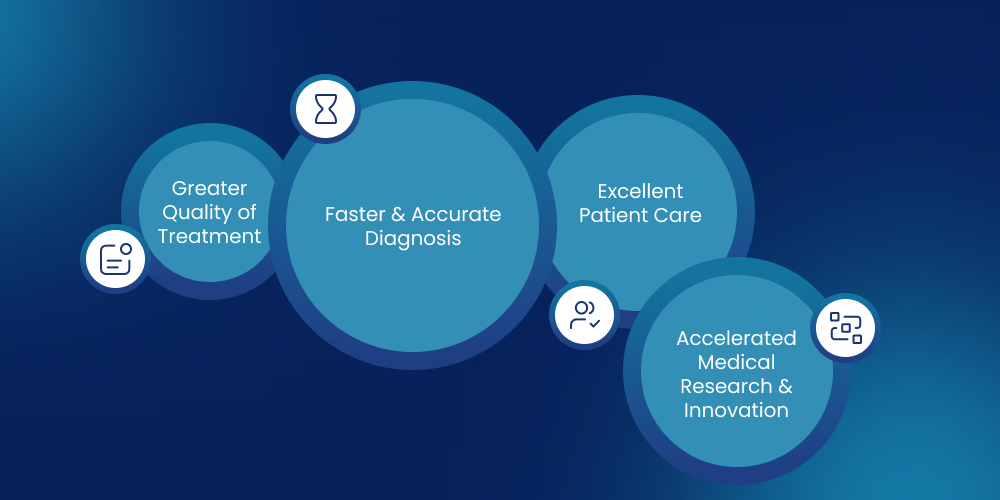
As healthcare practices increasingly adopt technology, the industry is experiencing profound improvements across several key areas. Let’s look at how these advancements are reshaping the healthcare landscape.
Faster & Accurate Diagnosis
With the help of software like EHRs, telemedicine, and RPM, diagnoses are becoming faster and more accurate. Instant access to patient records, continuous monitoring, and remote consultations give healthcare professionals the tools they need to diagnose conditions quickly and accurately, often before they become serious health issues.
Excellent Patient Care
Software solutions enable healthcare providers to deliver more personalized, timely, and effective care. Tools like telemedicine and health tracking empower patients to be more involved in their healthcare, fostering a stronger provider-patient relationship and improving the overall patient experience. When patients feel more engaged, their care outcomes improve significantly.
Greater Quality of Treatment
With continuous monitoring and real-time data analysis, healthcare providers can make more informed decisions about treatment plans. This data-driven approach enhances the quality of care by allowing for early interventions, personalized treatment adjustments, and more accurate clinical decisions, which collectively lead to better patient outcomes.
Accelerated Medical Research & Innovation
Healthcare software is also helping accelerate medical research by enabling faster data sharing, collaboration, and analysis. With easier access to large pools of patient data, researchers can uncover patterns, develop new treatments, and test medical theories more efficiently. This software-driven approach is speeding up the process of medical discovery, ultimately leading to innovations that can revolutionize healthcare.
How DITS Helps Your Practice with Custom Healthcare Software
At DITS, we understand the complexities of healthcare and are dedicated to providing software solutions that meet your specific needs. We are a fully customizable, scalable healthcare software solution company designed to streamline operations and improve patient care.
Comprehensive Solutions Our software covers all aspects of your healthcare practice—patient management, telemedicine, billing, and more—ensuring smooth operations from day one. We make sure everything integrates seamlessly with your existing systems, reducing friction and allowing you to focus on what matters most: patient care.
Customizable & Scalable Whether you’re a small practice or a large healthcare provider, we offer software solutions that adapt to your specific needs. As your practice grows, our solutions scale with you, ensuring long-term support and flexibility.
Reliable Support & Training With DITS, you won’t just receive software; you’ll get a partner. We provide dedicated support and training to ensure your team gets the most out of our products. Our goal is to help you implement and use the software effectively so your practice runs smoothly.
Affordable & Transparent Pricing We believe in offering high-quality software at competitive prices. With DITS, you get value-driven solutions with clear, transparent pricing. You’ll always know what you’re paying for and how it benefits your practice.
Security & Compliance Our software meets the highest standards for data security and compliance. HIPAA-compliant and built with industry best practices in mind, you can trust DITS to keep your patient data safe and your practice compliant.
DITS is committed to providing healthcare practices with software solutions that make a real difference. With our expertise and dedication, we empower your practice to deliver exceptional care while optimizing operations for long-term success.
Need help navigating healthcare software options? We’re here to guide you every step of the way. Contact us today!
FAQs
1. What is HealthTech software?
HealthTech software refers to digital tools designed to improve healthcare services, from patient care management and electronic health records (EHR) to telemedicine and medical billing. These solutions streamline operations, enhance care quality, and ensure compliance.
2. How does HealthTech software improve patient care?
HealthTech software allows healthcare professionals to access patient data in real-time, leading to faster, more accurate decisions. It also enables telemedicine and remote monitoring, enhancing convenience and access to care for patients.
3. What are the benefits of using Electronic Health Records (EHR)?
EHRs streamline patient data management, improving accuracy, reducing paperwork, and enhancing communication between healthcare providers. This leads to better care coordination, faster diagnosis, and improved patient outcomes.
4. Why is data security important in healthcare software?
Healthcare software deals with sensitive patient information, which must be protected under regulations like HIPAA. Ensuring data security helps prevent data breaches, maintains patient trust, and avoids legal consequences.
5. How can Telemedicine software benefit patients?
Telemedicine software allows patients to consult with doctors remotely, providing more flexible access to healthcare. It’s especially beneficial for patients in rural areas or those with limited mobility, offering convenient, efficient care without the need for travel.
6. What role does Remote Patient Monitoring (RPM) play in healthcare?
RPM enables healthcare providers to monitor patients’ vital signs and health conditions remotely. This reduces hospital visits, helps in managing chronic conditions, and provides real-time data for better decision-making.
7. Can healthcare software help with regulatory compliance?
Yes, healthcare software is designed to stay updated with ever-changing regulations like HIPAA. It automates compliance tasks, ensuring healthcare providers meet the required standards for data privacy, billing codes, and more.
8. What features should I look for in healthcare software?
Look for software that is customizable, integrates well with your current systems, ensures data security, is easy to use, and has reliable customer support. It should also be scalable to grow with your practice’s needs.
9. Is HealthTech software expensive?
While HealthTech software can be an investment, it offers significant returns in efficiency, patient care, and cost savings. Many solutions are priced competitively, and the ROI through improved operations and reduced errors often outweighs the initial cost.
10. How can HealthTech software improve the financial management of a healthcare practice?
HealthTech software simplifies billing, tracks payments, and automates insurance claims. It reduces errors, accelerates reimbursement, and helps healthcare providers manage finances more effectively, leading to better financial stability and revenue generation.
11. What are the different types of healthcare software used in the industry?
The healthcare industry utilizes various software types, including Electronic Health Records (EHR), Telemedicine platforms, Remote Patient Monitoring (RPM), Health Tracking & Monitoring, and Medical Billing software. Each type is designed to improve specific aspects of patient care, data management, and operational efficiency.
12. How does custom healthcare software development benefit healthcare practices?
Custom healthcare software development tailors solutions to meet the unique needs of a healthcare practice. It ensures seamless integration with existing systems, enhances functionality, and improves patient care while complying with regulatory requirements.

Nidhi Thakur
With more than 19 years of experience - I represent a team of professionals that specializes in the healthcare and business and workflow automation domains. The team consists of experienced full-stack developers supported by senior system analysts who have developed multiple bespoke applications for Healthcare, Business Automation, Retail, IOT, Ed-tech domains for startups and Enterprise Level clients.
Recent Posts
Get in touch
